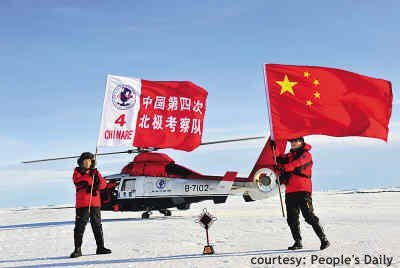A Potential Arctic Conflict: Insiders vs. Outsiders

One potential conflict in the Arctic exists between state interests and the social and economic demands of Arctic inhabitants. Another such conflict can be anticipated between Arctic in- and outsiders as the region becomes increasingly accessible. These conflicts all have different dimensions.
A potential area of conflict arises between Arctic and non-Arctic states. China, South Korea, Japan, Italy and the European Union as a whole have in recent years applied to become permanent observers to the Arctic Council, but so far without success. These entities have, however, already served as ad hoc observers to the Council.
China has been the most outspoken of all non-Arctic states in opening participation in Arctic governance to non-Arctic actors. The crucial argument, also articulated by Indian representatives, is that the Arctic is a global common and a common heritage of mankind and thus must be accessible to all interested in Arctic research, environmental protection, resource exploration, and navigation. Advocates of this argument have stated that “an end to the Arctic states’ monopoly of Arctic affairs is now imperative” and that the “Arctic states should strike a balance between their national interests and the common interests of the international community”.
Up to now Arctic Council member states have blocked the admission of new permanent observers to the Council, to add to the existing group of observers comprising France, Germany, Netherlands, Poland, Spain, and the United Kingdom. Traditionally Russia and Canada have been opposed to the admittance of new permanent observers. During the last Arctic Council Ministerial Meeting in Nuuk, however, new guidelines concerning the admission of permanent observers emerged which should make the process of assigning criteria for granting or denying observer status more transparent and comprehensive. These changes to the institutional workings of the Arctic Council may prove favorable for aspiring observer states.
A second area of conflict can be expected between Arctic coastal and non-coastal states. In May 2008 the five littoral states; the US, Canada, Norway, Russia and Denmark/Greenland; established an ad hoc institution in form of occasional foreign minister meetings, the first of which took place in Ilulissat, Greenland (Denmark). The meeting resulted in the adoption of the Ilulissat Declaration. The second meeting occurred in Chelsea, Canada in March 2010, where the Canadian Minister of Foreign Affairs emphasised the “stewardship role” that the five littoral states play in the region.
These meetings of the A5 have already been deemed a new forum for dealing with Arctic matters. The main goals of the meetings are: demonstrating the littoral states’ leadership position in the Arctic; and including only a small number of actors in the dialogue, which could potentially determine who is involved in the distribution of Arctic riches. The meetings took place to the exclusion of the other three Arctic Council member states: Sweden, Finland and Iceland, as well as non-Arctic states and non-state representatives-both Arctic and non-Arctic.
These developments highlight the third possible conflict, which is between states and sub-national, regional, and local representations. While most, if not all, international institutions relevant to the Arctic region (e.g. UNCLOS, IMO, OPRC, and OSPAR) are built upon government representation, the Arctic Council has made an effort at including non-state actors by including Arctic indigenous representatives as permanent participants and non-governmental organisations as observers to the Council. But the Arctic Council’s work explicitly excludes security concerns and remains primarily limited to issues related to the environment, sustainable development, climate change, research and emergency prevention.
Another issue is that decision-making remains the sole prerogative of Arctic Council member states: in decision-making processes permanent participants are merely consulted and have no voting rights. Also problematic is that due to the limitations of the Arctic Council’s agenda, many important Arctic issues are only addressed on national and bilateral levels.
Any successful Arctic policy approach, thus, cannot remain an exclusive concern of the five Arctic coastal states but instead must include many diverse state and non-state actors on local, regional, and international levels. A comprehensive policy and governance approach must take into account the layered nature of the problem and the multi-dimensional aspects of the conflict.